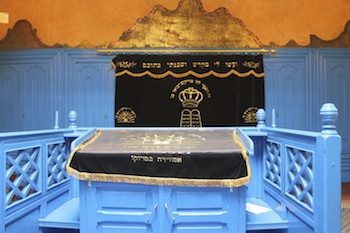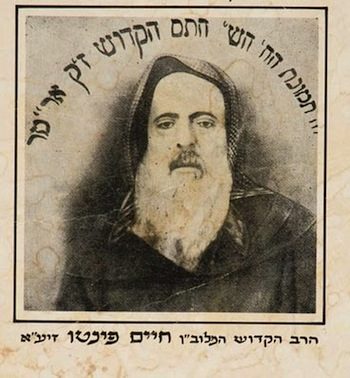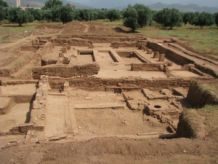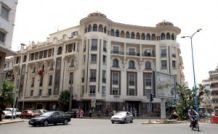
In the new Moroccan constitution adopted in 2011 in the context of the Arab Spring , His Majesty King Mohammed VI reaffirmed the “Hebrew distinctive characteristic” of Morocco as ” one of the age-old pieces ” of “its national identity”” and he called for “the restoration of all the Jewish temples ” in the Kingdom. In a message at the restoration ceremony of the 17th century Slat al Fassayine Synagogue in Fes, King Mohammed VI reiterated his commitment to religious freedom and spiritual diversity, and emphasized the importance of the three-thousand-year-old Jewish legacy in Morocco.
King Mohammed VI commended the institutions and individuals whose years of effort led to the restoration of Slat al Fassayine and called for the restoration of all Moroccan synagogues. Morocco is intent on making the Judeo-Moroccan cultural heritage a priority as part of its larger domestic program to preserve the unique and historic aspects of Moroccan culture.
“As is enshrined in the Kingdom’s new Constitution,” His Majesty said, “the Hebrew heritage is indeed one of the time-honored components of our national identity. For this reason, I wish to call for the restoration of all the synagogues in the other Moroccan cities so that they may serve not only as places of worship, but also as forums for cultural dialogue and for the promotion of our cultural values.”

Essaouira is the site of an annual pilgrimage to the grave of the renowned Rabbi Chaïm Pinto,known for many miracles during his lifetime, he died 1845. His home and synagogue are preserved as an historic and religious site. It is situated in the Mellah. The hiloula of Chaïm Pinto is held in September every year and is attended by many devout jews from all over the world..
The Chaim Pinto Synagogue, is an historic site in Essaouira, Morocco, formerly known as Mogador, and was the home and synagogue of Rabbi Chaim Pinto. Although there is no longer a Jewish community in Essaouira, the building is an active synagogue, used when pilgrims or Jewish tour groups visit the city. The synagogue is on the second floor of a three-story, courtyard building inside the walls of the old city that also contained Rabbi Pinto’s home and office. The building is of whitewashed plaster over masonry. The synagogue consists of a single large room. There are two women’s sections, one across the courtyard and one on the third floor, both with windows looking into the synagogue. The synagogue room underwent a modern renovation in line with the policy of restoring Morocco’s Jewish synagogues announced by King Mohammed VI, concealing the ceiling and column capitals, and painting the wood of the Torah Ark and Bimah light blue. The other synagogue being renovated is Slat Attias

Essaouira’s mellah covers over 10 percent of the town, but Jews constituted almost 40 percent of the population in the late 1880’s. Jewish stars on the doors to the mellah show the degree to which Jews were accepted in Essaouira, to the point that some of the richer Jews did not even live in the mellah. Commemorative plaques indicate the buildings in which synagogues were located. The Jewish community formed an important link with the outside world for Morocco not only as regards trade but also in terms of art and culture. André Elbaz the painter is one of many, who lives in France but always remembers his birth place, Essaouira, and continues to exhibit there at the Contemporary Art Centre at Essaouira.
Former inhabitants of Essaouira, most of them Jewish, formed a committee to rehabilitate the town. The Jewish cemetery, just outside the city gates, is extremely well-kept.

The cemetery is renowned as the site of an annual pilgrimage to Rabbi Haim Pinto. Annually, on the hillula or anniversary of the rabbi’s death (26 Ellul on the Jewish calendar), Jews from around the world come on pilgrimage to the rabbi’s grave. Essaouira was founded in 1765. The oldest tombs date from 1776. These tombs carved out of marine sandstone, are interesting. Contrary to Jewish tradition and Mosaic Law, they are sculptured with very marked human forms.
A famous citizen of Essaouira, the adviser to King Mohammed VI , André Azoulay ,who is Jewish, has said that his birthplace Essaouira is, “the single place in the Arab world equipped with a population mainly Jewish until 1930, could be used today as example for the dialogue between the Jews and the Moslems throughout the world”
During the 19th century the Jewish population in Essaouira grew from 4,000 to 12,000 from 1830 to 1912, and declined to about 6500 in 1936.This is attributed to the decline of commerce and other economic activity during the French Protectorate era in Mogador in favor of Casablanca and Agadir.
The immigration trends of the 1950s and 1960s caused the Mogador Jewish community to dwindle. n the early 1970s most of its Jewish community members resided in USA,Canada, Europe and Israel. By 2005, the community had almost disappeared.
Essaouira used to be an example of a small town in which Muslims and Jews lived side by side in both rich and poor districts, working together but socially segregated – and in peace. The rise of Essaouira as a commercial port in the 19th century because of the cotton trade and the links with major ports such as Manchester and Liverpool saw the Jewish community involved in export –import trade in Essaouira reach its zenith. It was unique because there were almost as many Jews as there were Muslims, so the term “minority” did not really apply, as it did in every other town and city in Morocco and everywhere in the Arab world.
Aside from ownership of the land in and around the town, which always remained in the hands of the caids and makhsen – local landed gentry and royal family clans – most urban-style import-export business was dominated by Jewish families.
The one exception was all artisan work connected to wood, directly linked to the vast forests around the town. From the very beginning of royal trading in the 18th century, the Corcos family dominated the import of tea leaves from Britain, which originated from its Far East colonies, and was thus responsible for making tea the traditional morning beverage in Morocco.
Essaouira’s last Jews began to leave following the Six Day War. Many of the working-class families left the mellah, the Jewish district in Arab cities, for Israel. The Kasbah’s well-off business leaders headed mostly to France and Canada. But thousands of Jews remain here, buried in two cemeteries on the edge of town, including Rabbi Chaim Pinto. Thousands of Jews return each year to venerate his tomb and those of the many Moroccan Jewish saints and ancestors uniting them with their past and also celebrating the future.
Many religious schools, a yeshiva, and several English-French Jewish schools were founded in Essaouira in the 1800s. In the early 20th century, the Jewish population in Essaouira was still higher than the Muslim population, and urban life was regulated by the Jewish calendar.
Essaouira’s real beginning as a import-export center came in 1760 when the sultan of Morocco appointed families from Casablanca, Marrakech and other northern cities to settle here and become official royal traders. Many if not most were Jewish. The town grew. According to Ottmani, seven of the town’s leading families in the 19th century were Muslim, while 25 were Jewish, with names such as Corcos, Afriat, Bensaoud, Cohen Solal, Belisha, Ohana, Pinto and El-Maleh.
In the beginning, these families conducted trade by ship mostly with Britain, but also handled local trade and the camel caravans coming from Timbuktu across the desert, with links to Algiers, Tunis, Tripoli, Cairo and Mecca. In modern times the caravans disappeared, but international trade focused on Europe became highly competitive.
The silver jewelry work was famous for the much sought-after filogram design, the Dag Ed Essaouiri – thin lines converge on a circular center as meticulous radii, a design that was instantly recognizable as native to Essaouira. The master silversmiths were all Jewish, as were many of the workers, who lived mostly in the mellah. Today, the remaining silver designers are Berbers, many of whom worked with the local Jews until they left. The local Arab jewelers all work in gold. Israel has been a part of the attempt to commercialize. There is an ongoing attempt to link French-speaking Jews back to their countries of origin in North Africa. In some cases, it has been successful, as French and Canadian Sephardim, and in some cases Israelis, have bought homes there.
The Essaouira Alliance Israélite Universelle School, was founded in 1765. While no longer an Alliance school, the building remains the same, with its open courtyard, narrow staircases, and rooftop view of the Atlantic ocean.
For More Information about the Essaouira’s Jewish Heritage or an Essaouira Tour
Morocco’s Imperial Cities, Seaside Resorts,Sahara Desert,Berber villages, A Taste of Morocco, Magical Kasbahs, Ruins & Waterfalls, Absolute Morocco, The Best of Marrakech, Fes, and Ouarzazate






